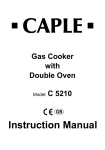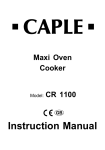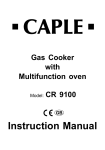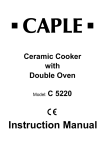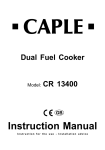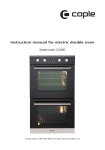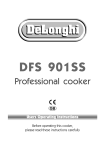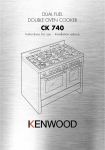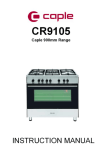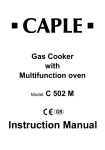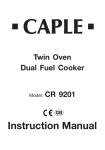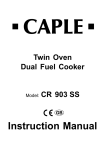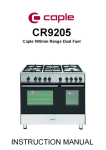Download Caple CR 7200 Instruction manual
Transcript
Cooker Model: CR 7200 GB Instruction Manual Instruction for the use - Installation advice Thank you for buying your new CAPLE cooker. To ensure that you get the best results from your new CAPLE cooker, we strongly suggest that you read this instruction manual thoroughly before use. This manual contains installation advice, cleaning tips and a cooking guide, as well as other important facts about your CAPLE cooker. If treated with care, your CAPLE appliance should give you years of trouble-free cooking. For Spare Parts, Technical Advice or Product Service call the CAPLE HELPLINE on 0870 241 1142 (Answerphone outside office hours) Important: This appliance is designed and manufactured solely for the cooking of domestic (household) food and is not suitable for any non domestic application and therefore should not be used in a commercial environment. This appliance guarantee will be void if the appliance is used within a non domestic environment i.e. a semi commercial, commercial or communal environment. IMPORTANT INFORMATION FOR CORRECT DISPOSAL OF THE PRODUCT IN ACCORDANCE WITH EC DIRECTIVE 2002/96/EC. At the end of its working life, the product must not be disposed of as urban waste. It must be taken to a special local authority differentiated waste collection centre or to a dealer providing this service. Disposing of a household appliance separately avoids possible negative consequences for the environment and health deriving from inappropriate disposal and enables the constituent materials to be recovered to obtain significant savings in energy and resources. As a reminder of the need to dispose of household appliances separately, the product is marked with a crossed-out wheeled dustbin. The CE marking confirms that the appliance conforms to the following EU directives: - safety requirements of EEC Directive “Gas” 90/396; - safety requirements of EEC Directive “Low voltage” 73/23; - protection requirements of EEC Directive “EMC” 89/336; - requirements of EEC Directive 93/68. 2 Safety Reminders Instruction Book DO NOT line the ovens, grids, trays etc. This appliance should only be used for it’s intended purpose as described in these instructions. Ensure that you fully understand these instructions before operating this appliance. with aluminium foil as this could adversely affect the heating elements and it could also damage the interior surfaces. Do not place baking trays or the drip tray on the base of the oven chamber. Space Requirements the ovens. Ensure that the specified ventilation space around the appliance is not obstructed. Faults DO NOT place flammable materials in Food Splashes Always wipe clean the oven after use. Food splashes can carry on cooking next time and may become a fire hazard. Hot Surfaces It is important to remember that the surfaces of cooking appliances get hot during use and retain the heat for some time after switching off. It is therefore advisable to keep small children away from the appliance. Do not continue to use this appliance if it appears to be faulty. After Use After use, ensure that the hob knobs are in position ● (off), and close the main gas delivery valve or the gas cylinder valve. Switch the oven controls off. Always switch off at the isolating switches before cleaning the appliance, or attempting any maintenance task. CAPLE Service The Grill and Top oven element (Top oven only) are exposed, so take great care when placing food in the ovens or removing it. Use the grill pan handles or gloves. To ensure the continued safe and efficient operation of this appliance, we recommend that any servicing or repairs are carried out only by an authorised CAPLE SERVICE ENGINEER. Before Use Check that all accessories have been removed from the oven interior. Set the temperature to the maximum position using the temperature control knob. Leave on for approximately 30 minutes. This will burn off any protective coating applied to the oven during manufacture. The kitchen should be well ventilated during this time as there may be an odour given off. When cool, wash the accessories and the oven with warm water and mild detergent. 3 1 - Electrical Installation - Wall box connection IMPORTANT: The appliance must be installed in accordance with the manufacturer’s instructions. Incorrect installation, for which the manufacturer accepts no responsibility, may cause damage to persons, animals and things. General – Connection to the mains must be carried out by qualified personnel in accordance with current regulations. – The appliance must be connected to the mains checking that the voltage corresponds to the value given in the rating plate and that the electrical cable sections can withstand the load specified on the plate. – The cooker can be connected directly to the mains placing an omnipolar switch with minimum opening between the contacts of 3 mm between the appliance and the mains. – The power supply cable must not touch the hot parts and must be positioned so that it does not exceed 75°C at any point. The connection of the appliance to earth is mandatory. The manufacturer declines all responsability for any inconvenience resulting from the inobservance of this condition. IMPORTANT: This cooker must be connected to a suitable double pole control unit adjacent to the cooker. NO DIVERSITY CAN BE APPLIED TO THIS CONTROL UNIT. WARNING! Before effecting any intervention on the electrical parts the appliance must be disconnected from the network. Feeder cable section type H05RR-F 3 x 2,5 mm2 (**) 230 V (**) – Connection with wall box connection. – Once the cooker has been installed, the switch must always be accessible. N.B. For connection to the mains, do not use adapters, reducers or branching devices as they can cause overheating and burning. 230 V If the installation requires alterations to the domestic electrical system call an expert. He should also check that the socket cable section is suitable for the power absorbed by the appliance. 4 L1 N PE (L2) Fig. 1.1 Electrical feeder cable connection To connect the feeder cable to the cooker it is necessary to: – Remove the 2 screws that hold shield A behind the cooker. – Open completely the cable clamp D. – Insert the feeder cable into the cable save P. The supply cable must be of a suitable size for the current requirements of the appliance; see the section “Feeder cable section”. – Connect the phase and earth cables to terminal B according to figures 1.2 and 1.1. – Pull the feeder cable and block it with the cable clamp D. – Re-mount shield A. Technical data 230 V AC - 50 Hz Top conventional oven – Top element – Bottom element – Grill element 0.700 kW 1.000 kW 2.000 kW Bottom fan oven – Fan element 2.200 kW Maximum power rating – Top oven – Bottom oven 2.000 kW 2.200 kW Oven lamp 0.015 kW 300 °C, miniature edison screw Fan motor Maximum power usable simultaneusly 0.025 kW 4,275 kW N.B. The earth conductor must be left about 3 cm longer than the others. B A D P Fig. 1.2 5 FOR THE INSTALLER 2 - Location The cooker must be installed by a qualified technician and in compliance with local safety standards. 450 mm 650 mm This cookers has class “2/1” overheating protection so that it can be installed next to a cabinet. The furniture walls adjacent to the cooker must be made of material resistant to heat. The veneered syntetical material and the glue used must be resistant to a temperature of 105°C in order to avoid ungluing or deformations. If the cooker is installed adjacent to furniture which is higher than the gas hob cooktop, a gap of at least 200 mm must be left between the side of the cooker and the furniture. The cooker may be located in a kitchen, a kitchen/diner or bed-sitting room but not in a room containing a bath or shower. Curtains must not be fitted immediatly behind appliance or within 500 mm of the sides. The cooker is equipped with 4 levelling feet which must be fitted to the base of the cooker. It is essential that the cooker is positioned as stated below. If the cooker is located on a pedestal it is necessary to provide safety measures to prevent falling out. 200 mm 500 mm 6 Fig. 2.1 Adjustable feet ■ Before installing the cooker level the appliance by screwing or unscrewing the six adjustable feet fitted below. WARNING! For safety reasons unscrew the feet (from screwed position) to the maximum extent of 5 mm (fig. 2.2). Fig. 2.2 Backguard Before installing the cooker, assemble the backguard “C” (fig. 2.3). ■ Before assembling remove any protective film/adhesive tape. ■ Remove the two spacers “A” and the screw “B” from the rear of the cooktop. ■ Assemble the backguard as shown in figure 2.3 and fix it by screwing the central screw “B” and the spacers “A”. It is mandatory to install the backguard. B C A Fig. 2.3 7 MOVING THE COOKER WARNING When raising cooker to upright position always ensure two people carry out this manoeuvre to prevent damage to the adjustable feet (fig. 2.4). Fig. 2.4 WARNING Be carefull: do not lift the cooker by the door handle when raising to the upright position (fig. 2.5). 8 Fig. 2.5 WARNING When moving cooker to its final position DO NOT DRAG (fig. 2.6). Lift feet clear of floor (fig. 2.4). Fig. 2.6 Provision for ventilation The room containing the cooker should have an air supply in accordance with BS.5540: Part 2: 1989. All rooms require an openable window or equivalent while some rooms require a permanent vent in addition to the openable window. The cooker should not be installed in a bed-sitting room, of volume less than 21 m3. Where a DOMESTIC COOKER is installed in a room or internal space, that room or internal space shall be provided with a permanent opening which communicates directly with outside air and is sized in accordance with table below. In domestic premises the permanent opening shall be an air vent. If there are other fuel burning appliances in the same room, BS.5540: Part 2: 1989 should be consulted to determine the requisite air vent requirements. If the cooker is installed in a cellar or basement, it is advisable to provide an air vent of effective area 100 cm2, irrespective of the room volume. MINIMUM PERMANENT OPENING FREE AREA FOR FLUELESS APPLIANCE Type of appliance Domestic oven, hotplate, grill or any combination thereof. > 20 m3 Openable window or equivalent also required Nil cm2 Yes Room volume Maximum appliance rated input limit < 5 m3 None 100 cm2 5 m3 to 10 11 m3 to m3 20 m3 50 (❊) cm2 Nil cm2 (❊) If the room or internal space containing these appliances has a door which opens directly to outside, no permanent opening is required. 9 3 - Gas connection Gas installation Important note This appliance is supplied for use on NATURAL GAS only and cannot be used on any other gas without modification. This appliance is manufactured for conversion to LPG if required and is supplied with a conversion kit. The cooker must be installed by a qualified person in accordance with the Gas Safety (Installation and Use) (Amendment) Regulation 1990 and the relevant building/l.E.E. Regulations. The following British Standards should be used as reference when installing this appliance. BS6172 1990, BS5440 part 2 1989 and BS6891 1988. Failure to install the appliance correctly could invalidate any manufacturers warranty and lead to prosecution under the above quoted regulation. In the UK C.O.R.G.I registered installers are authorised to undertake the installation and service work in compliance with the above regulations. Fig. 3.1 cooker rear protection gas pipe 10 Gas connection The installation of the cooker to Natural Gas or LP Gas must be carried out by a qualified gas engineer. Installer shall take due account of the provisions of the relevant British Standards Code of Practice, the Gas Safety Regulations and the Building Standards (Scotland) (Consolidation) Regulations issued by the Scottish Development Department. Installation to Natural Gas Installation to Natural Gas must conform to the Code of Practice, etc. The supply pressure for Natural Gas is 20 mbar. Installation to LP Gas This appliance must only be connected to LPG after an LPG conversion kit has been fitted, (see pages from 12 to 13). When operating on Butane gas a supply pressure of 28-30 mbar is required. When using Propane gas a supply pressure of 37 mbar is required. The installation must conform to the relevant British Standards. Warning: Only a qualified gas engineer, also with technical knowledge of electricity should install the cooker. He should observe the Regulations and Codes of Practice governing such installation of gas cookers. Note: It is recommended that the gas connection to the cooker is installed with a flexible connecting tube made to BS 5386. Gas connection The gas supply must be connected to the gas inlet which is located at the rear of the appliance (see figure 3.1). If the connection pipe cross the cooker, it must be positioned under the cooker rear protection. To screw the connecting tube operate with two spanners (see fig. 3.2). After connecting to the mains, check that the coupling are correctly sealed, using soapy solution, but never a flame. Fig. 3.2 11 Conversion to LPG Conversion procedure Injectors replacement J Select the injectors to be replaced according to the “Table for the choice of the injectors”. To replace the injectors proceed as follows: - Remove pan supports and burners from the cooktop. - Using a wrench, substitute the nozzle injectors “J” (fig. 3.3, 3.4) with those most suitable for the kind of gas for which it is to be used. The burners are conceived in such a way so as not to require the regulation of the primary air. Fig. 3.3 J Minimum burner setting adjustment In the minimum position the flame must have a length of about 4 mm and must remain lit even when turned quickly from the maximum position to minimum. The flame adjustment is done in the following way: - Turn on the burner - Turn the tap to the MINIMUM position - Take off the knob - With a small flat screwdriver turn the screw inside the tap rod to the correct regulation (fig. 3.5). Fig. 3.4 Normally for G30/G31, the regulation screw is tightened up. 12 Fig. 3.5 GB TABLE FOR THE CHOICE OF THE INJECTORS Cat: II 2H3+ BURNERS Auxiliary (A) Nominal Power [kW] Reduced Power [kW] 1,00 0,30 G 30 - 28-30 mbar G 31 - 37 mbar G 20 20 mbar Ø injector Ø injector [1/100 mm] [1/100 mm] 50 72 (X) Semi-rapid (SR) 1,75 0,45 65 97 (Z) Rapid (R) 3,00 0,75 85 115 (Y) Triple-ring (TR) 3,50 1,50 95 135 (T) INCREASE OF AIR NECESSARY FOR GAS COMBUSTION (2 m3/h x kW) BURNERS Air necessary for combustion [m3/h] Auxiliary (A) 2,00 Semi-rapid (SR) 3,50 Rapid (R) 6,00 Triple-ring (TR) 7,00 Lubrication of the gas taps If the gas tap becomes stiff, it is necessary to dismount it accurately clean it with gasoline and spread a bit of special grease resistant to high temperatures on it. The operations must be executed by a qualified technician. IMPORTANT All intervention regarding installation maintenance and conversion of the appliance must be fulfilled with original factory parts. The manufacturer declines any liability resulting from the non-compliance of this obligation. 13 4 - Features and Technical Data 2 2 4 1 3 Fig. 4.1 Cooking hob 1. Auxiliary burner (A) 2. Semi-rapid burner (SR) 3. Rapid burner (R) 4. Triple ring burner (TC) Cooker - Cat: - 1,00 kW - 1,75 kW - 3,00 kW - 3,50 kW Note: The electric ignition is incorporated in the knobs. 14 II 2H3+ Control Panel 10 11 Fig. 4.2 A 9 8 7 6 5 4 3 2 1 Control panel - Controls description 1. Front right rapid burner control knob (3) 2. Rear right semi-rapid burner control knob (2) 3. Central triple-ring burner control knob (4) 4. Rear left semi-rapid burner control knob (2) 5. Front left auxiliary burner control knob (1) 6. Conventional oven thermostat knob (top oven) 7. Conventional oven switch knob (top oven) 8. Fan oven switch/thermostat knob (bottom oven) 9. Electronic programmer (bottom oven only) 10. Indicator light (bottom oven) 11. Indicator light (top oven) Please note: This appliance incorporates a safety cooling fan which you will hear operating whenever the top/bottom oven are in use. The cooling fan may also operates when the oven is switched off. 15 How To Use the Hob Burners Hob burners Each hob burner is controlled by a separate gas tap operated by a control knob (fig. 4.3) which has 3 positions marked on the knob, these are: – Symbol ● : tap closed (burner off) – Symbol : High (maximum) – Symbol : Low (minimum) Push in and turn the knob anti-clockwise to the selected position. Low High Fig. 4.3 To turn the burner off, fully rotate the knob clockwise to the off position: ●. The maximum setting of the control tap is for boiling, the minimum setting is for slow cooking and simmering. All working positions must be chosen between the maximum and minimum setting, never between the maximum setting and the “OFF” position. Lighting of the hob burners To ignite the burner, the following instructions are to be pursued: 1) Lightly press and turn the knob anti-clockwise, and make knob indicator to mach with the symbol printed on the control panel (fig. 4.3). 2) Press the knob to operate the electric ignition; or, in case of power cut, approach a flame to the burner. 3) Adjust the burner according to the power required. Electric ignition The sparks generated by the electrodes close to the burners will ignite the chosen burner. Whenever the lighting of the burners will result difficult due to peculiar conditions of the gas features or supply, it is advised to repeat the ignition with the knob on “minimum” position. 16 Choice of burner The burner must be chosen according to the diameter of the pans and energy required. Fig. 4.4 Burners Pan diameter Auxiliary Semi-rapid Rapid Triple-ring Wok 12 ÷ 14 cm 16 ÷ 24 cm 24 ÷ 26 cm 26 ÷ 28 cm max 36 cm do not use pans with concave or convex bases Saucepans with handles which are excessively heavy, in relationship to the weight of the pan, are safer as they are less likely to tip. Pans which are positioned centrally on burners are more stable than those which are offset. It is far safer to position the pan handles in such a way that they cannot be accidentally knocked. When deep fat frying fill the pan only one third full of oil. DO NOT cover the pan with a lid and DO NOT leave the pan unattended. In the infortunate event of a fire, leave the pan where it is and turn off all controls. Place a damp cloth or correct fitting lid over the pan to smother the flames. DO NOT use water on the fire. Leave the pan to cool for at least 30 minutes. Caution! The cooking hob becomes very hot during operation. Keep children well out of reach. 17 Correct use of triple-ring burner The flat-bottomed pans are to be placed directly onto the pan-support. When using a WOK you need to place the supplied stand in the burner to avoid any faulty operation of the triple-ring burner (Fig. 4.5 - 4.6). IMPORTANT: The special grille for wok pans (fig. 4.6) MUST BE PLACED ONLY over the pan-rest for the triple-ring burner. CORRECT WRONG Fig. 4.5 18 Fig. 4.6 5 - How To Use the Top Conventional oven Attention: the oven door becomes very hot during operation. Keep children away. General features The convection oven is equipped with 3 electrical heating elements: NOTE: Upon first use, it is advisable to operate the oven at the maximum temperature (thermostat knob on position MAX) for 60 minutes in the position and for another 15 minutes in the mode in order to eliminate any traces of grease from the electrical resistances. – 2 elements (upper and lower) for normal oven cooking – 1 grill element, on the top of the oven, for grilling which must be done with the oven door closed. The input of the elements is: – Upper element, 700 W – Lower element, 1000 W – Grill element, 2000 W WARNING: The door is hot, use the handle. Fig. 5.1 Operating principles Heating and cooking in the CONVENTIONAL oven are obtained in the following ways: a. by natural convection The heat is produced by the upper and lower heating elements. b. by radiation The heat is radiated by the infra red grill element (use with the oven door closed). Fig. 5.2 19 Thermostat knob (Fig. 5.2) This only sets the cooking temperature and does not switch the oven on. Rotate clockwise until the required temperature is reached (from 50°C to MAX). Function selector knob (Fig. 5.1) Rotate the knob clockwise to set the oven for one of the following functions. Oven light The oven is equipped with a light that illuminates the oven to enable visually controlling the food that is cooking. This light is controlled by the function selector knob (fig. 5.1). It remains on in all the cooking modes. Traditional convection cooking The upper and lower heating elements come on. The heat is dispersed by natural convection and the temperature must be set to between 50° and MAX°C via the thermostat knob. The oven must be preheated before cooking. Recommended for: Food that requires the same degree of cooking both inside and out, for example roasts, spare pork ribs, meringues etc. Lower heating element In this position only the lower element is switched on. Heat is distributed by natural convection. The thermostat can be set between 50 and 150°C; higher temperatures are not available. Recommended for: This mode is particularly suitable to complete cooking of dishes that require higher temperature at the bottom. Upper heating element In this position only the upper element is switched on. Heat is distributed by natural convection. The thermostat can be set between 50 and 150°C; higher temperatures are not available. 20 Recommended for: This mode is particularly suitable to complete cooking of dishes that require higher temperature at the top. Grilling The infra-red heating element is switched on. The heat is diffused by radiation. Use with the oven door closed and the thermostat knob to between 50°C and 200°C. For correct use see chapter “USE OF THE GRILL” Before using the grill, preheat for about five minutes. Always grill with the oven door closed and do not use the grill for longer than 30 minutes at any one time. Recommended for: Intense grilling, browning, cooking au gratin and toasting etc. Note: It is recommended that you do not grill for longer than 30 minutes at any one time. Attention: the oven door becomes very hot during operation. Keep children away. Use of the grill Leave to warm up for approximately 5 minutes with the door closed. Place the food inside positioning the rack as near as possible to the grill. Insert the drip pan under the rack to collect the cooking juices. Grilling with the oven door closed. Do not grill for longer than 30 minutes at any one time. Attention: the oven door becomes very hot during operation. Keep children away. Oven cooking Before introducing the food, preheat the oven to the desired temperature. For a correct preheating operation, it is advisable to remove the tray from the oven and introduce it together with the food, when the oven has reached the desired temperature. Check the cooking time and turn off the oven 5 minutes before the theoretical time to recuperate the stored heat. 21 6 - How To Use the Bottom Main oven Attention: the oven door becomes very hot during operation. Keep children away. Note: Upon first use, it is advisable to operate the oven at the maximum temperature (thermostat knob on position 250) for 60 minutes to eliminate any traces of grease from the electrical resistance. General features Operating principles Fan cooking is more economical and quicker than cooking in a conventional oven. The moving hot air surrounds the food and penetrates it more quickly than in a conventional oven. Heating and cooking in this oven are obtained by forced convection. A fan sucks in the air contained in the oven muffle, which sends it through the circular heating element and then sends it back through the muffle. Before the hot air is sucked back again by the fan to repeat the described cycle, it envelops the food in the oven, provoking a complete and rapid cooking. It is possible to cook several dishes simultaneously. Attention: the oven door becomes very hot during operation. Keep children away. The oven is equipped with a circular element (2200 W) and a fan. IMPORTANT To open the bottom door operate as indicated in fig. 6.1. WARNING: The door is hot, use the handle. Fig. 6.1 22 Switch and temperature selector (fig. 6.2) Rotate the knob clockwise to set the oven for one of the following functions: Off as per fig. 6.2 Only the oven fan is on. The fan operates without the heating element, this function can be used for defrosting. 50 to 250 The oven light is switched on. The oven temperature can be set between 50°C - 250°C. The set temperature has been reached when the temperature indicator light goes off. Several different meals may be cooked simultaneously on various shelves, as the heated air circulates evenly throughout the oven. The hot air system cooks more quickly than conventional static system, therefore the temperature should be set 15°C - 20°C below the values recommended in your recipe books. Fig. 6.2 23 Cooking Advice Sterilization Sterilization of foods to be conserved, in full and hermetically sealed jars, is done in the following way: a. Set the selector knob to position 185 °C and preheat the oven. b. Fill the dripping pan with hot water. c. Set the jars onto the dripping pan making sure they do not touch each other and the door and set the knob to position 135 °C. When sterilization has begun, that is, when the contents of the jars start to bubble, turn off the oven and let cool. Regeneration Set the selector knob to position 150° C. Bread becomes fragrant again if wet with a few drops of water and put into the oven for about 10 minutes at the highest temperature. Roasting To obtain classical roasting, it is necessary to remember: – that it is advisable to maintain a temperature between 180 and 200 °C. – that the cooking time depends on the quantity and the type of foods. Oven cooking Before introducing the food, preheat the oven to the desired temperature. For a correct preheating operation, it is advisable to remove the tray from the oven and introduce it together with the food, when the oven has reached the desired temperature. Check the cooking time and turn off the oven 5 minutes before the theoretical time to recuperate the stored heat. Simultaneous cooking of different foods The fan consents a simultaneous heterogeneous cooking of different foods. Different foods such as fish, cake and meat can be cooked together without mixing the smells and flavours together. This is possible since the fats and vapours are oxidized while passing through the electrical element and therefore are not deposited onto the foods. The only precaution to follow are: – The cooking temperatures of the different foods must be as close to as possible, with a maximum difference of 20° - 25 °C. – The introduction of the different dishes in the oven must be done at different times in relation to the cooking times of each one. The time and energy saved with this type of cooking is obvious. 24 Recommended cooking temperature Food °C °F Gas Mark Shelf Position* Cooking Time (approx) CAKES Victoria sandwich Small cakes/buns Maidera cake Fruit cake Rich fruit cake Scones 190 190 180 170 150 225 375 375 350 325 300 425 5 5 4 3 2 8-9 2 or 3 1 and 2 2 or 3 3 3 or 4 2 20-25 mins 15-20 mins 20 mins 13/4 hours 21/2 hours 8-10 mins PASTRY Puff Short crust Plate tarts Quiches and flans 225 200 200-210 200-210 425 400 400-410 400-410 8-9 6 6 6 2 2 1 or 2 1 or 2 10-20 mins 20-30 mins 30-35 mins 40-45 mins 225 220 230 425 425 450 7-8 7 8 2 1 or 2 2 35-55 mins 15-20 mins 20 mins 190 190 190-200 190 190 180 150-170 375 375 375-400 375 375 350 300-325 5 5 5-7 5 5 4 2-3 2 or 3 2 or 3 2 or 3 2 or 3 2 or 3 2 or 3 2 or 3 20 mins/lb + 20 mins 25-30 mins/b + 25 mins 30 mins/lb + 30 mins 30 mins/b + 30 mins 30 mins/b + 30 mins 18-20 mins/b + 20 mins 11/2 2 hours YEAST Bread loaf Bread rolls Pizza dough ROAST MEAT Beef – Medium Lamb Pork Veal Chicken Turkey up to 10lb Stews/casseroles N.B. For fan ovens reduce the temperature by 10-20°C. For any dish taking one hour or over to cook, reduce the cooking time by 10 minutes per hour. * Shelf positions have been counted from the top of the oven to the base. A fan oven creates more even temperature throughout, therefore the shelf positions are not as critical. 25 7 - Electronic programmer (Bottom main oven only) The electronic programmer is a device with the following functions: ■ 24 hours clock with illuminated display ■ Timer (up to 23 hours and 59 minutes) ■ Program for automatic oven cooking ■ Program for semi-automatic oven cooking Description of the buttons: Timer Cooking time End of cooking time simultaneously: Switching to manual and program reset Minus function to decrease the number shown on the display or to change the buzzer frequency Plus function to increase the number shown on the display Description of the illuminated symbols: A flashing: Programmer in automatic position but not programmed A always illuminated: Programmer in automatic position with program inserted. Automatic cooking taking place Timer in operation and A flashing: Program error. (The time of day lies between the calculated cooking start and end time). Note: Select a function by pressing the respective button and, in 5 seconds, set the required time with the / buttons (“one-hand” operation). A power cut makes the clock go to zero and cancels the set programs. A 26 Fig. 7.1 SETTING TIME OF DAY (fig. 7.2) The programmer is provided with an electronic clock with luminous figures showing the hour and minutes. The first time the oven is connected up to the electricity supply and after a power cut, three zeroes will flash on the programmer display. To adjust the time, the two buttons must be pressed simultaneously and then the button or until the correct time is set. Setting speed automatically increases if you keep the setting buttons pressed. Fig. 7.2 MANUAL OPERATION To use the oven manually, i.e. without the programmer, you must cancel the flashing A by pressing the two buttons simultaneously (the letter A will go out and the symbol will come on). CANCELLING A PROGRAMME Fig. 7.3 If the letter A is not flashing (which means that a cooking program has already been set) by pressing the two buttons simultaneously you will cancel the program and switch to manual. If the oven is on, you must switch it off manually. 27 MINUTE MINDER The minute counter function consists simply of an acoustic signal which can be set for a maximum of 23 hours 59 minutes. If the letter A is flashing, press the two buttons simultaneously. To set the time, press button and then button or until the required time appears on the display (Fig. 7.4). The symbol will come on. Countdown will begin immediately and can be seen on the display at any time by simply pressing button . Fig. 7.4 When the time expires, the symbol will go out and an intermittent acoustic signal will come on which can be switched off by pressing any of the buttons. AUDIBLE SIGNAL The audible signal sounds at the end of a minute minder cycle or of a cooking programme for a period of 7 minute. The signal can be cancelled by pressing any function button. Pressing the button without having previously selected a function the frequency of the signal change. You can choose from three variations. The selected signal is audible as long as the button is pressed. 28 Fig. 7.5 SEMI-AUTOMATIC COOKING This automatically switches the oven off after the required cooking time. There are two methods of semi-automatic cooking: 1° METHOD: Programming the cooking time (Fig. 7.6) – Set the cooking time by pressing button and then button to move forward or to move back if you have gone beyond the required time. The letter A and the symbol will appear. A Fig. 7.6 2° METHOD: Programming the end of cooking time (Fig. 7.7) – Set the end of cooking time by pressing button and then button to move forward or to move back if you have gone beyond the required time. The letter A and the symbol will appear. Having programmed according to one of the above methods, set the temperature and function via the function selector and thermostat knob (see specific chapters). The oven will come on immediately and when the set time or programmed end of cooking time expires, it will automatically switch off. During cooking the letter A and the symbol remains on; press button to display the remaining time until end of cooking or press button to display the end of cooking time. The cooking program can be cancelled at any time by pressing the two buttons simultaneously. A Fig. 7.7 At the end of cooking, the oven switch off, the symbol go out, the letter A flash and the acoustic signal come on this can be switched off by pressing any of the buttons. Reset the function selector and thermostat knob and set the programmer to manual by pressing the two buttons simultaneously. 29 AUTOMATIC COOKING To cook in the oven in automatic mode follow the instructions below: 1. Set the cooking time 2. Set the end of cooking time 3. Set the cooking temperature and function These operations are carried out as follows: 1. Set the cooking time by pressing button and then to move forward or to move back if you have gone beyond the required time (fig. 7.8). The letter A and the symbol appear. 2. Press button ; the cooking time already added to the clock time appear. Set the end of cooking time by pressing button ; if you go beyond the required time, you can go back by pressing button . The symbol go out and the letter A remains on (fig. 7.9). If during the setting the letter A begins to flash on the display and the acoustic signal comes on, this indicates a programming error, i.e. the cooking cycle has been superimposed on the clock time. In this case alter the end of cooking time or the cooking time as above. 3. Set the cooking temperature and function via the function selector and thermostat knob (see specific chapters). The oven is now programmed and everything will work automatically; the oven will come on as required and finish cooking at the programmed time. At the start of the cooking the symbol appear. During cooking the letter A and the symbol remains on; press button to display the remaining time until end of cooking or press button to display the end of cooking time. The cooking program can be cancelled at any time by pressing the two buttons simultaneously. At the end of cooking, the oven switch off, the symbol go out, the letter A flash and the acoustic signal come on this can be switched off by pressing any of the buttons. Reset the function selector and thermostat knob and set the programmer to manual by pressing the two buttons simultaneously. Caution: If the electricity supply is cut off (the display numbers will flash), the clock will reset and all the programs entered will be cancelled. 30 A Fig. 7.8 A Fig. 7.9 8 - Cleaning and Maintenance General advice – Important: Before any operation of cleaning and maintenance disconnect the appliance from the electrical network. – It is advisable to clean when the appliance is cold. – When the appliance is not being used, it is advisable to keep the gas tap closed. – Every now and then check to make sure that the flexible tube that connects the gas line or the gas cylinder to the appliance is in perfect condition and eventually substitute it if it shows signs of wearing or damage. – The periodical lubrication of the gas taps must be done only by specialized personnel. – If a tap becomes stiff, do not force; contact your local Service Centre. Attention The appliance gets very hot, mainly around the cooking areas. It is very important that children are not left alone in the kitchen when you are cooking. Do not use a steam cleaner because the moisture can get into the appliance thus make it unsafe. 31 Cleaning Gas tap All the enamelled parts must be cleaned with a sponge and soapy water or other non-abrasive products. Dry preferably with a soft cloth. Acidic substances like lemon juice, tomato sauce, vinegar etc. can damage the enamel if left too long. If a tap becomes stiff, do not force; contact your local Service Centre. Stainless steel surfaces (coated) CAUTION The STAINLESS STEEL front panels on this cooker (facia, oven doors) are protected with a Special Lacquer to reduce finger-print marks. To avoid damaging this lacquer, do not clean the stainless steel with abrasive cleaners or abrasive cloths or scouring pads. ONLY SOAP/WARM WATER MUST BE USED TO CLEAN THE STAINLESS STEEL SURFACES. Stainless steel surfaces (uncoated) The hob + sides are made from un-coated stainless steel and can be cleaned with an appropriate stainless steel cleaner. 32 Flexible tube From time to time, check the flexible tube connecting the gas supply to the cooker. It must be always in perfect condition; in case of damage arrange for it to be replaced by a C.O.R.G.I. registered installer. Cleaning oven parts after use The oven interior and the chromium plated shelves can be cleaned by damp soapy cloth. Obstinate stains can be removed with nylon scouring pads and gentle, non-abrasive, liquid cleaner. Provided the oven is wiped over immediately after roasting, only the minimum of cleaning should be necessary. Inside of ovens This must be cleaned regularly. Remove and refit the side runner frames as described in the next chapter. With the oven warm, wipe the inside walls with a cloth soaked in very hot soapy water or another suitable product. Side runner frames, tray and rack can be removed and washed in the sink. Attention: Do not store flammable material in the ovens. Assembling and removing the side racks – Assemble the wire racks to the oven walls using the 2 screws (Fig. 8.1). – Slide the tray and rack into the runners fig. 8.2. The rack must be fitted so that the safety catch, which stops it sliding out, faces the inside of the oven. – To dismantle, operate in reverse order. Fig. 8.1 Fig. 8.2 33 Burners They can be removed and washed only with soapy water. Detergents can be used but must not be abrasive or corrosive. Do not use abrasive sponges or pads. Do not put in dishwasher. After each cleaning, make sure that the burner-caps, as well as the burners, have been well wiped off and CORRECTLY POSITIONED. It is essential to check that the burner flame distributor “F” and the cap “C” has been correctly positioned (see fig. 8.3-8.4) - failure to do so can cause serious problems. Check that the electrode “S” (fig. 8.3) is always clean to ensure trouble-free sparking. Note: The electrode “S” must be very carefully cleaned. To avoid damage to the electric ignition do not use it when the burners are not in place. C F S Fig. 8.3 34 Fig. 8.4 Triple ring burner The triple ring burner must be correctly positioned (see fig. 8.7); the burner rib must be enter in their logement as shown by the arrow (see fig. 8.5). Then position the cap A and the ring B (fig. 8.6 - 8.7). The burner correctly positioned must not rotate (fig. 8.6). Fig. 8.5 A B Fig. 8.6 Fig. 8.7 35 Replacing the ovens light Before any maintenance is started involving electrical parts of the appliance, it must be disconnected from the power supply. – Let the oven cavity and the heating elements cool down; – Switch off the electrical supply; – Unscrew the protective cover (fig. 8.8); – Unscrew and replace the bulb with a new one suitable for high temperatures (300°C) having the following specifications: 230 V 50 Hz, 15W, E14 – Refit the protective cover Removing the bottom oven door The oven door can easily be removed as follows: – Open the door. – Unscrew the 4 screws of the bottom hinge (fig. 8.10) – Hold the door and unscrew the 3 screws of the upper hinge (fig. 8.9). – Remove the door following the arrow C (fig. 8.9 - 8.10) – Rest the door on a soft surface. – To replace the door, repeat the above steps in reverse order. NOTE: Oven bulb replacement is not covered by your guarantee c Fig. 8.9 c 2 1 Fig. 8.8 36 Fig. 8.10 Removing the top oven door The oven door can easily be removed as follows: – Open the door to the full extent (fig. 8.11a). – Open the lever “A” completely on the left and right hinges (fig. 8.11b). – Hold the door as shown in fig. 8.11. – Gently close the door until left and right hinge levers “A” are hooked to part “B” of the door (figs. 8.11b 8.11c). Fig. 8.11a A B – Withdraw the hinge hooks from their location following arrow “C” (fig. 8.11d). – Rest the door on a soft surface. – To replace the door, repeat the above steps in reverse order. Fig. 8.11b Fig. 8.11c C Fig. 8.11 Fig. 8.11d 37 Helpful Advice Trouble shooting Problem Food too brown but not cooked. Remedy Turn down the oven temperature slightly and cook a little longer Problem Food cooked but not brown enough. Remedy Increase temperature. Problem Food baking unevenly. Remedy 1. The temperature may be slightly high turn it down 2. Position the food in the centre of the shelves rather than towards the sides of tho oven. 3. Rotate the food a half turn in the oven. 4. Try pre-heating the oven for 5-15 minutes prior to baking. Always remove cooked items as soon as they are ready and continue cooking the undercooked items until they are completely finished. Changing the Oven Cavity Light Bulb. If the oven light falls: 1. Turn off the cooker by switching the oven selector knob to the OFF position, switch off at the cooker point. 2. When the oven is cool, reach back and upwards inside the oven, the bulb is in the top right corner. 3. Unscrew the light glass cover, replace the bulb with a new one of the same specification and screw the cover back until it is hand tight. NOTE: Oven bulb replacement is not covered by your guarantee. Other bulbs cannot be changed by yourself and should be replaced by an authorised CAPLE Service Engineer. 38 IMPORTANT: Ovens get hot. Keep children away from this appliance at all times. If Your Oven Does Not Work Before calling a CAPLE service engineer run through the following checklist. 1. The cooker is connected to the power supply and that the fuse is intact. 2. Make sure the timer control is set to the manual position, and that the oven has not been set inadvertently for an automatic or timed programme (bottom main oven only). If you are in any doubt about carrying out these checks, call the CAPLE Helpline on 0870 241 1142. A charge will be made if the appliance is found to be in working order, or if it has not been installed in accordance with these instructions, or if it is has been used incorrectly. 39 CAPLE “Built-in” Service Should you require service at any time, please contact the Caple Helpline on 0870 241 1142. Caple have a nationwide service network of engineers who will respond quickly to your call. Always replace spare parts with genuine Caple spares. These are available from authorised Caple Service Centres or by mail order from our National Service Stores, simply telephone 0870 241 1142. When ordering parts always quote the model number and serial number of your appliance. YOUR GUARANTEE CAPLE guarantees all parts of this product for one year from the date of purchase. During that time, should it become necessary CAPLE engineers will replace or repair all defective parts free of charge, except for parts subject to fair wear and tear, such as lightbulbs. Parts and the engineers labour costs are chargeable after the first 12 months. To qualify for benefits under the guarantee, you must be able to provide proof of date of purchase and the appliance must have been supplied, installed and used for domestic purposes only in accordance with CAPLE instructions. Consequential losses and accidental damage to the product are not covered by the guarantee. This guarantee does not affect your statutory or common law rights. CAPLE cannot be responsible for the results of using this appliance for any other purposes other than those described in these instructions. Cod. 1102674 - ß2








































